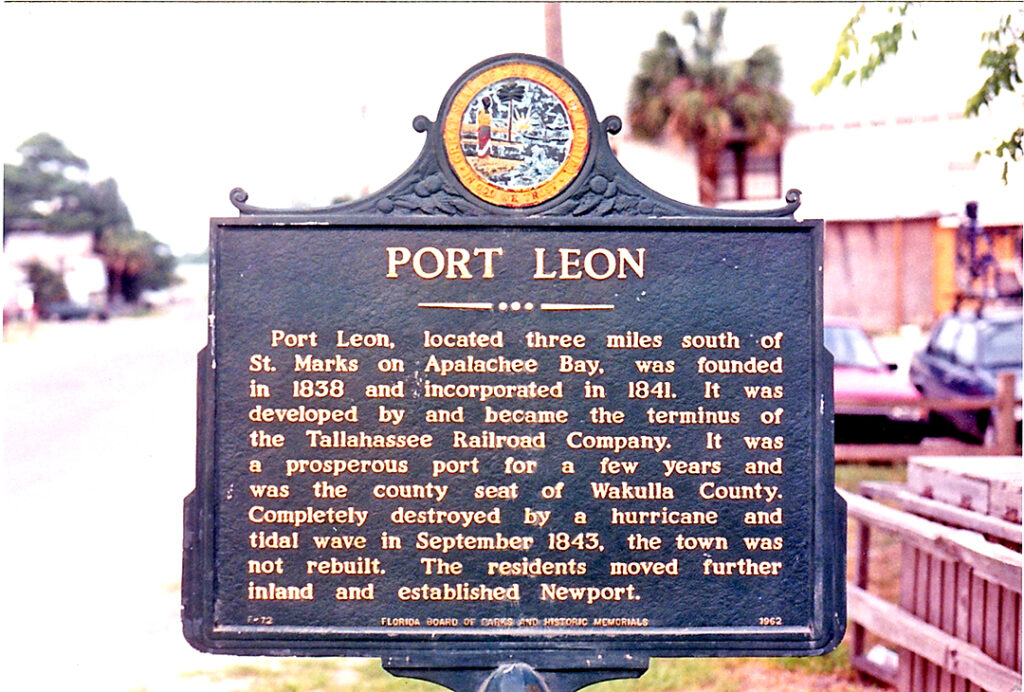By Elizabeth F. Smith, published in the Magnolia Monthly in 1964

Chapter Three
Apparently the town of St. Marks did not profit from the decline of Magnolia.
According to an article in the July 1876 issue of the Semitropical Magazine, St. Marks, in expectation of having the railroad and the resultant prosperity, laid out new streets, built some fine residences, planted fine gardens and set out shade trees to add to its attractions.
“But,” says the article, “the railroad company held the cards and St. Marks saw with dismay the iron horse dash across the river seeking cheap government land to retail in costly town lots.”
Thus “Port Leon was born with the sole advantage of being three miles nearer New York.”
We can readily believe that only getting 10 acres of land in the vicinity of the old fort, instead of the 100 acres asked for, was the chief reason the railroad company extended its line down the river.* That it expected to build a town and profit from selling land to settlers is indicated by the following advertisement appearing in the Pensacola Gazette of December 21, 1839:
SALE OF LOTS IN PORT LEON
On Monday, January 13, 1840, will be offered for sale, at auction, a part of the lots in Port Leon. This town is situated on Apalachie Bay, about 3 miles by the river, below St. Marks. It is handsomely located on the most elevated site on the bay, and with the exception of the ground near the bay, is beyond the influence of the highest tides.
The railroad from this point to Tallahassee, a distance of 24 miles, is now completed and in full operation. A wagon road equal in point of construction to any in the Southern country, has been constructed from Port Leon to the public road north and east of Port Leon. This road presents the nearest and best route to market that now exists, to all the extensive and fertile district of country. Besides these facilities to commerce, it is proposed to engage as the state of the river will permit, one or more steamboats in running from Port Leon up the Suwannee and the streams emptying into it, both from the east and west bank as far as they are respectively navigable. Port Leon being the nearest shipping point to the Suwannee and its tributaries all the adjacent country to that river as far north as the county of Lowndes in Georgia, and as far east as the Alachua prairie on the Santa Fe, can ship their produce and receive their supplies through this medium, at a cheaper rate and more promptly than through any other channel.
On the country lying north, east and west of Tallahassee, which is entirely dependent on this port for an outlet, it is unnecessary to say anything in commendation as it is known to be the largest and most productive body of good land in Florida, and already occupied by a wealthy and enterprising population. Several of the richest counties in South Georgia, also make this their shipping port. The great desideratum to a commercial people of speedy communication with distant markets is secured to Port Leon, by the establishment of the Brunswick and Florida line of Steamboats and Stages to Charleston and Mobile. The land route terminating and steamboat line commencing on the Gulf of Mexico at this place. A few lots were sold in town last spring that they might be improved and be in readiness this winter for business. On all the water lots sold, spacious and permanent buildings are erected, some of which are finished, and all in rapid progress of completion.
The health of the place during the last summer has been good, and it is believed will become the resort of the inhabitants of the interior during the summer months, as it has the full enjoyment of the sea breeze, and gives promise of exemption from the fevers of the country. (The town was nearly wiped out just a year later by a yellow fever epidemic. – Ed.) The crop of cotton in 1839 that will be shipped from this bay, will be between 30 and 40 thousand bales. The country tributary is yet in its infancy, and the constant increase of imports and exports may be safely relied on for many years to come. With these advantages, Port Leon cannot fail to become in a short time a place of principal importance in Florida.
The advertisement was signed by T. R. Betton, secretary of the Tallahassee Railroad Company, which is sufficient proof that this corporation was the promoter of the new city where such roseate hopes were to be realized.
*In the Tuesday, February 18, 1964 issue of The Tallahassee Democrat, a news article stated the State Cabinet released $30,000 to Wakulla County for the purpose of buying up privately owned property around the site of Ft. St. Marks in preparation for a state historical monument. (So little have times changed, but prices have gone up.) The 1963 Florida Legislative Session voted a sum of $100,000 towards creating the monument and an adjoining recreational park. Meanwhile, the Wakulla County Commissioners have cleared off the land and built an access road to the remains of the old Magnolia Cemetery two miles north of Newport.
The Wakulla County Historical Society Museum is in the Old Jail at 24 High Drive in Crawfordville. Visit us online at WakullaHistory.org.

